Abstract
We examined the relations between bronchial reactivity, baseline FEV1, and annual decline of height corrected FEV1 (delta FEV1/ht3) over 7.5 years in 227 men (117 smokers, 71 ex-smokers, and 39 non-smokers). Men with a clinical diagnosis of asthma or receiving bronchodilator treatment were excluded. Bronchial reactivity was determined as the provocation concentration (PC20) of inhaled histamine sufficient to reduce FEV1 by 20%; subjects were divided into reactors (PC20 less than or equal to 16 mg/ml) and non-reactors (PC20 greater than 16 mg/ml). Thirty per cent of smokers, 24% of ex-smokers, and 5% of non-smokers were reactors. When smokers who were reactors were compared with non-reactors, the reactors showed a lower baseline FEV1 as percentage predicted in 1981-2 (85% v 108%), and a faster delta FEV1/ht3 (14.1 v 9.2 ml/y/m3). Baseline FEV1 correlated with PC20 in both smokers (rs = 0.51) and ex-smokers (rs = 0.61), and all 15 subjects with an FEV1 under 80% of the predicted value were reactors. In ex-smokers delta FEV1/ht3 was similar in reactors and non-reactors (m 9.0 v 7.4 ml/y/m3), despite significant differences in baseline FEV1. When analysis was confined to men with a baseline FEV1 over 80% predicted, the prevalence of reactors was significantly increased among smokers and slightly increased among ex-smokers compared with non-smokers, though the mean FEV1 was higher in the non-smokers. Bronchial reactivity was not increased in smokers aged 35 years or less. In smokers delta FEV1/ht3 was faster in those with a personal history of allergy (usually allergic rhinitis), but was not related to a family history of allergic disease, total serum immunoglobulin E level, absolute blood eosinophil count, or skinprick test score. delta FEV1/ht3 was also faster in all subjects taking beta blocker drugs. Thus increased bronchial reactivity was associated with accelerated decline of FEV1 in smokers. Although the association could be a consequence of a lower lower baseline FEV1, a trend towards increased reactivity was found in smokers with normal baseline FEV1 and delta FEV1/ht3 was dissociated from increased reactivity in ex-smokers. These findings are compatible with the "Dutch hypothesis," but the association between allergic features and accelerated delta FEV1/ht3 was relatively weak, and increased reactivity may follow rather than precede the onset of smoking.
Full text
PDF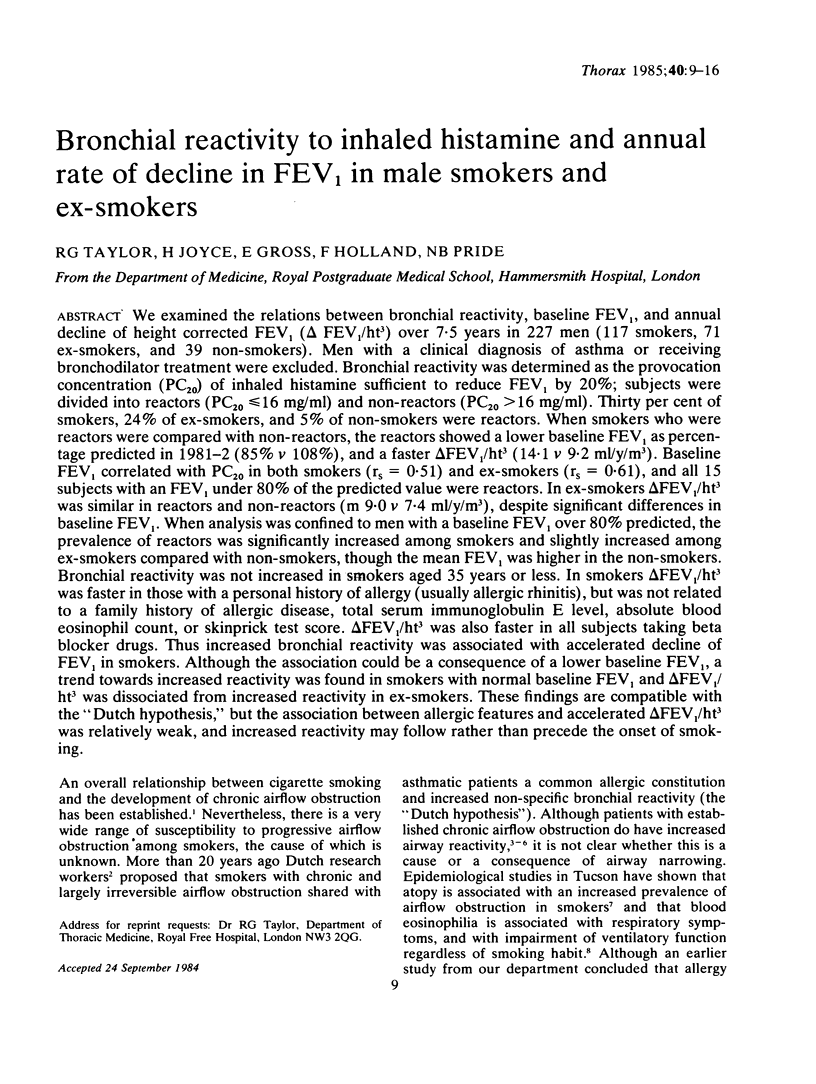
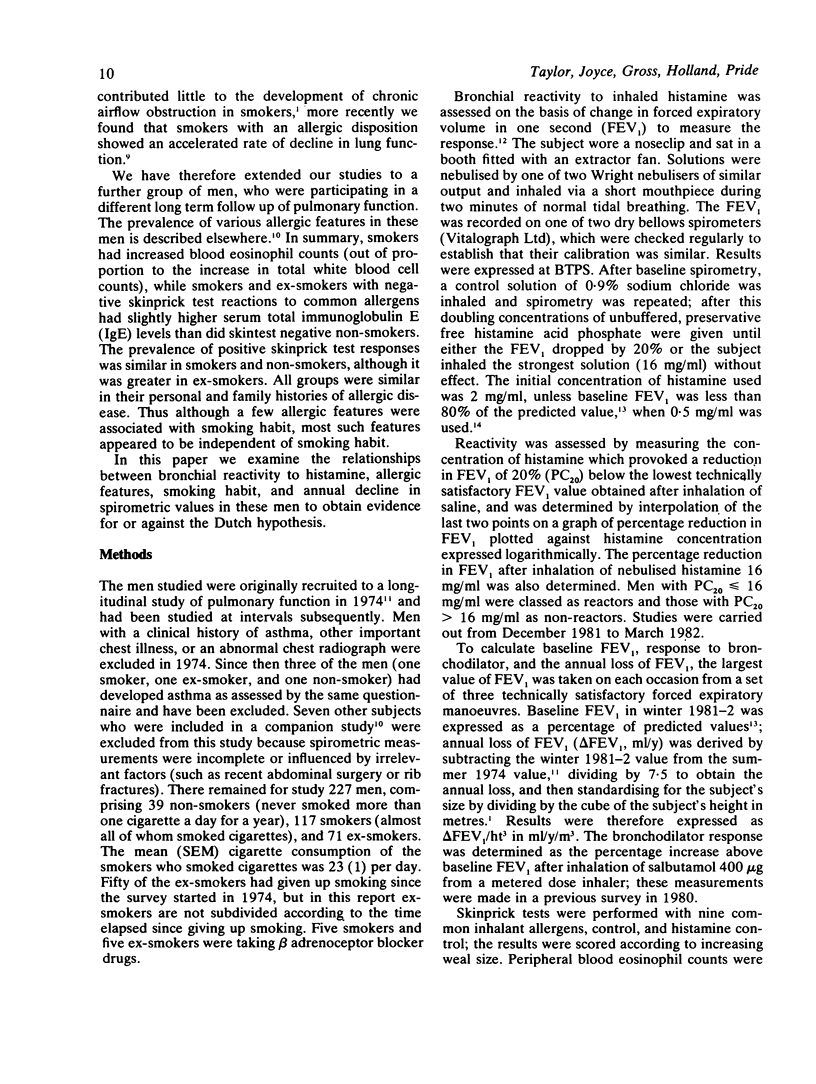

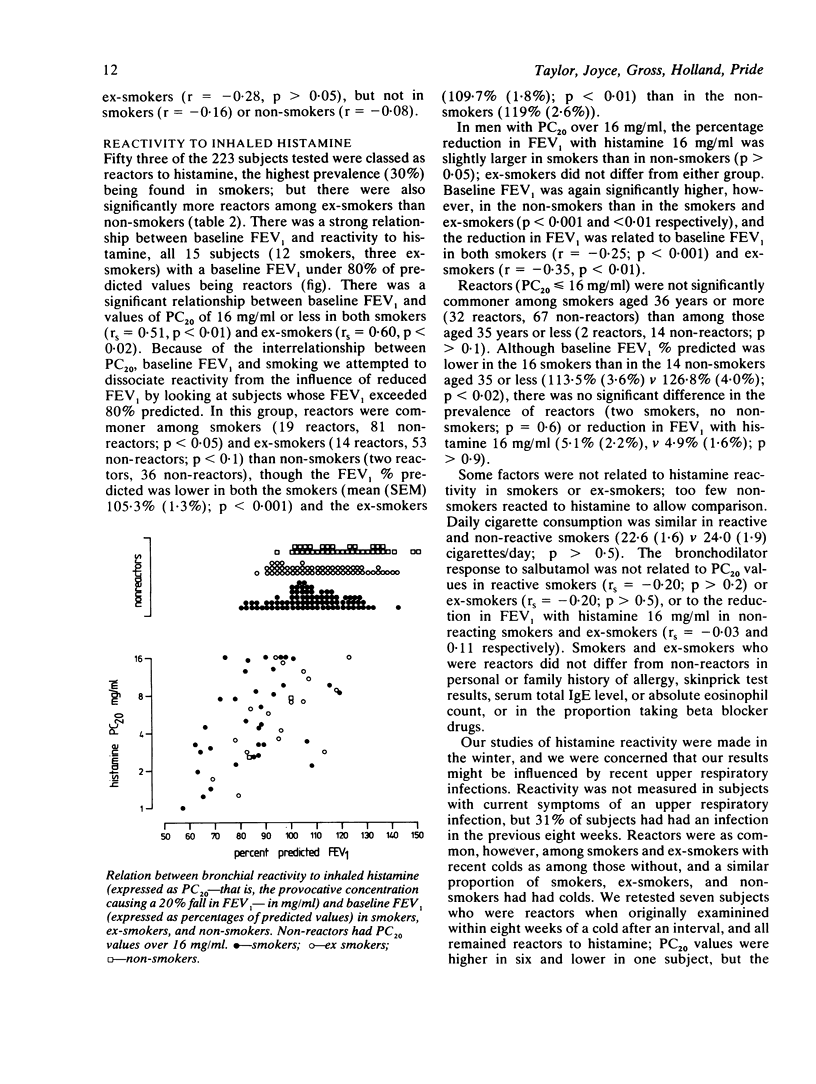
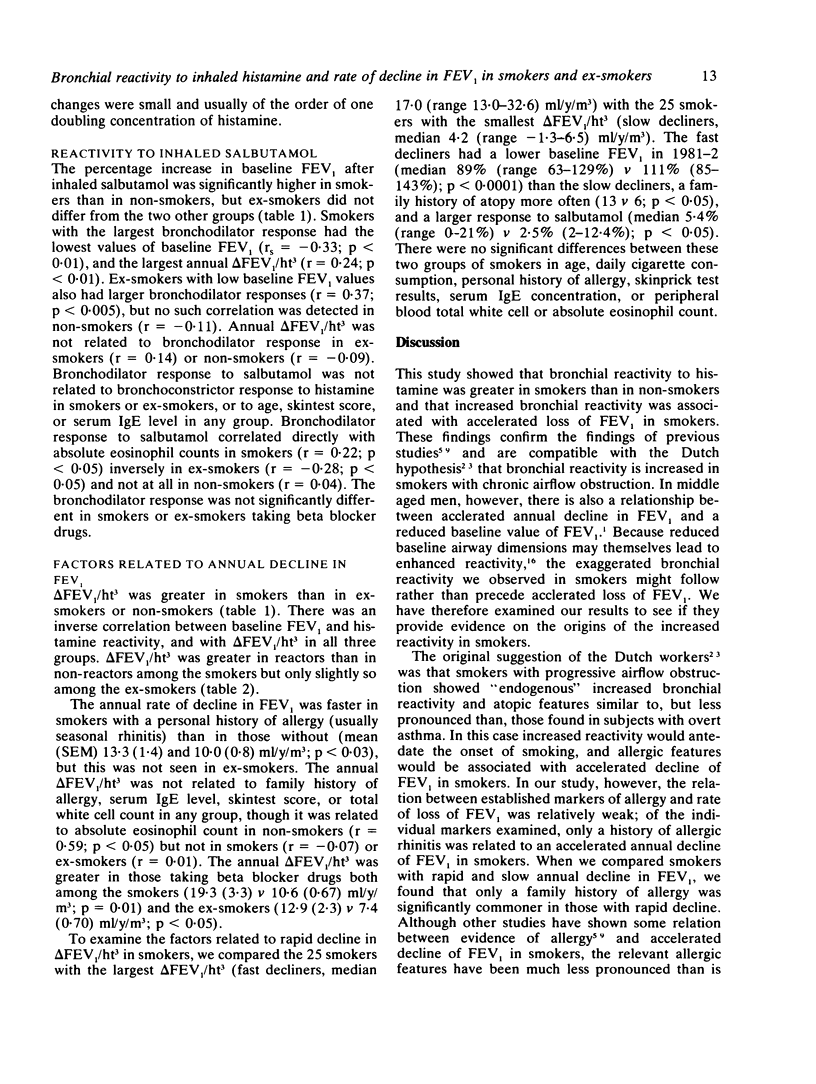
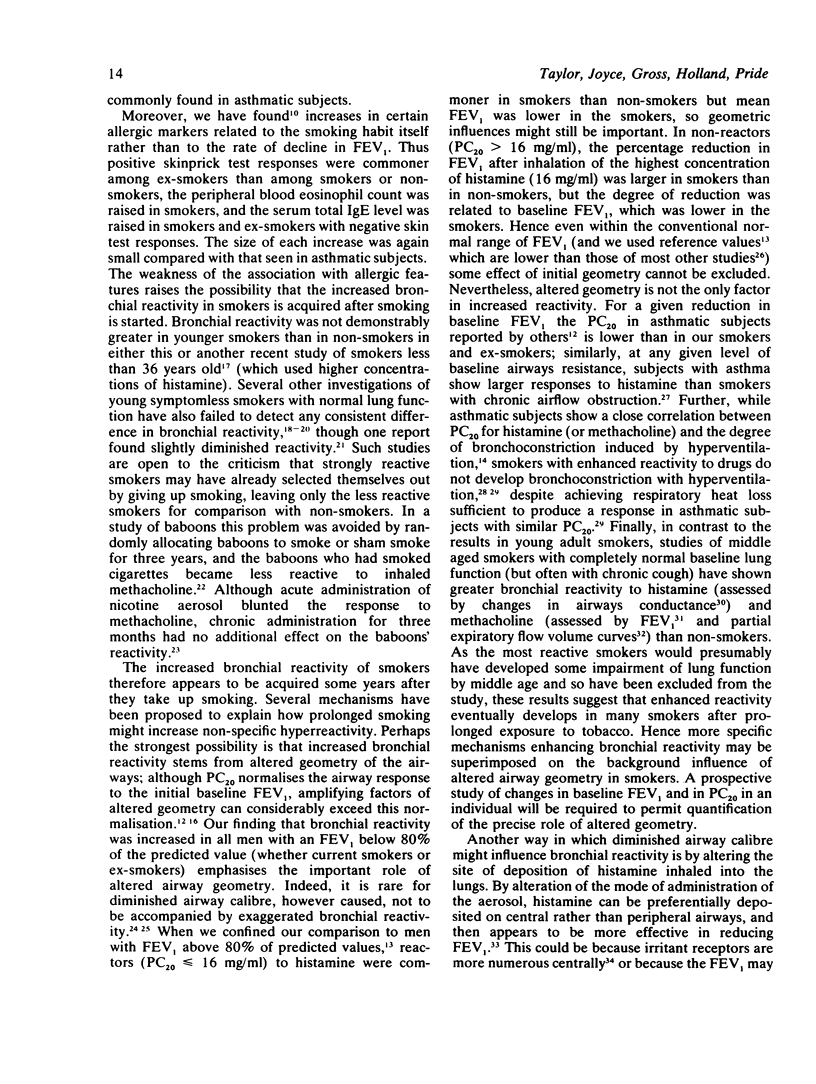
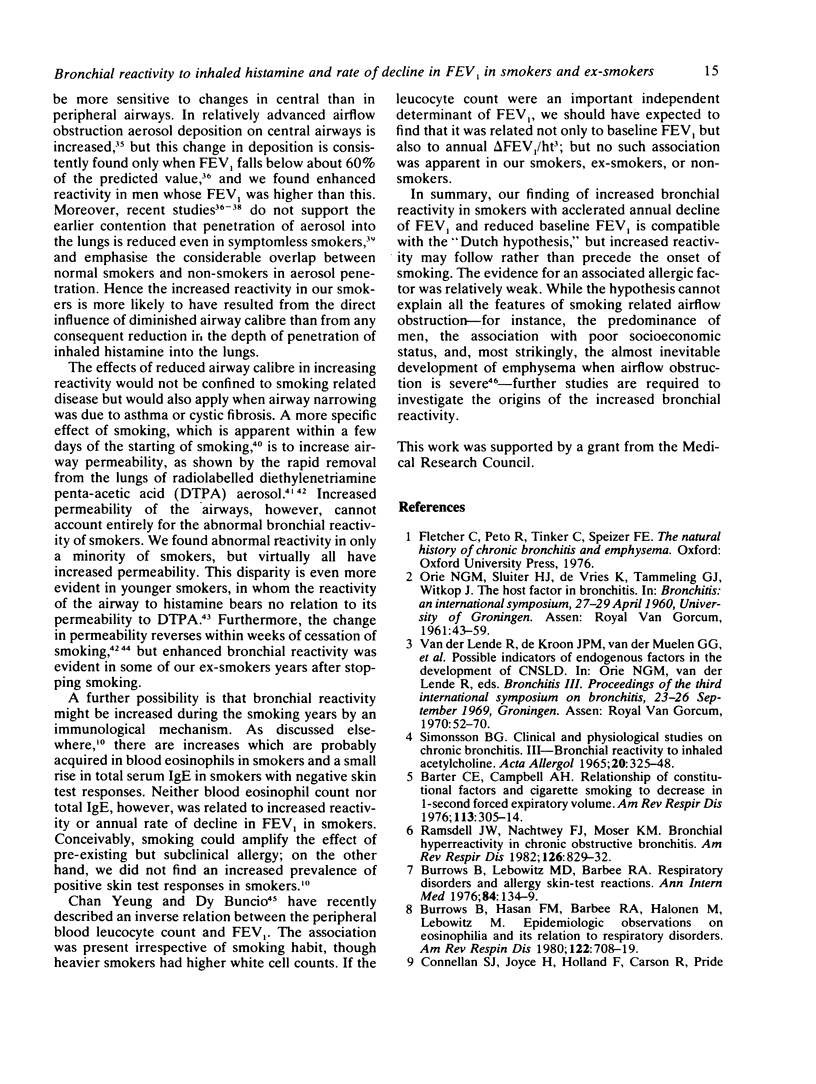
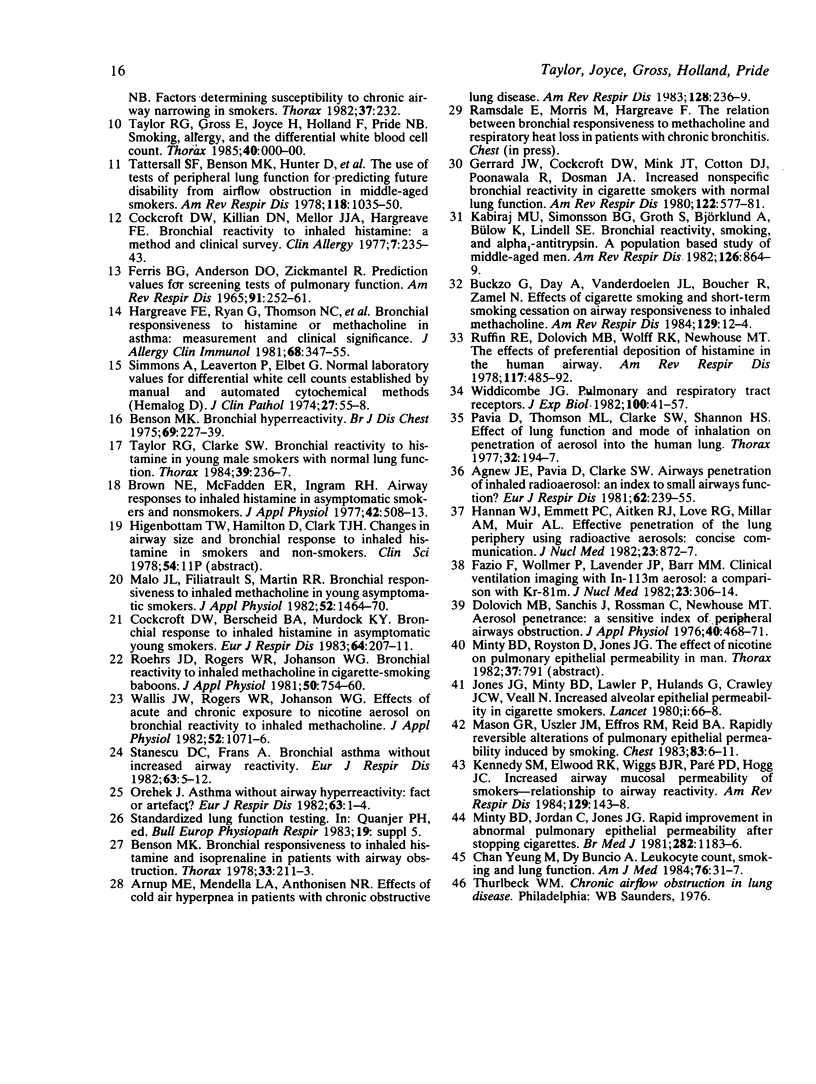
Selected References
These references are in PubMed. This may not be the complete list of references from this article.
- Agnew J. E., Pavia D., Clarke S. W. Airways penetration of inhaled radioaerosol: an index to small airways function? Eur J Respir Dis. 1981 Aug;62(4):239–255. [PubMed] [Google Scholar]
- Arnup M. E., Mendella L. A., Anthonisen N. R. Effects of cold air hyperpnea in patients with chronic obstructive lung disease. Am Rev Respir Dis. 1983 Aug;128(2):236–239. doi: 10.1164/arrd.1983.128.2.236. [DOI] [PubMed] [Google Scholar]
- Barter C. E., Campbell A. H. Relationship of constitutional factors and cigarette smoking to decrease in 1-second forced expiratory volume. Am Rev Respir Dis. 1976 Mar;113(3):305–314. doi: 10.1164/arrd.1976.113.3.305. [DOI] [PubMed] [Google Scholar]
- Benson M. K. Bronchial hyperreactivity. Br J Dis Chest. 1975 Oct;69(0):227–239. doi: 10.1016/0007-0971(75)90090-x. [DOI] [PubMed] [Google Scholar]
- Brown N. E., McFadden E. R., Jr, Ingram R. H., Jr Airway responses to inhaled histamine in asymptomatic smokers and nonsmokers. J Appl Physiol Respir Environ Exerc Physiol. 1977 Apr;42(4):508–513. doi: 10.1152/jappl.1977.42.4.508. [DOI] [PubMed] [Google Scholar]
- Buczko G. B., Day A., Vanderdoelen J. L., Boucher R., Zamel N. Effects of cigarette smoking and short-term smoking cessation on airway responsiveness to inhaled methacholine. Am Rev Respir Dis. 1984 Jan;129(1):12–14. doi: 10.1164/arrd.1984.129.1.12. [DOI] [PubMed] [Google Scholar]
- Burrows B., Lebowitz M. D., Barbee R. A. Respiratory disorders and allergy skin-test reactions. Ann Intern Med. 1976 Feb;84(2):134–139. doi: 10.7326/0003-4819-84-2-134. [DOI] [PubMed] [Google Scholar]
- Cockcroft D. W., Berscheid B. A., Murdock K. Y. Bronchial response to inhaled histamine in asymptomatic young smokers. Eur J Respir Dis. 1983 Apr;64(3):207–211. [PubMed] [Google Scholar]
- Cockcroft D. W., Killian D. N., Mellon J. J., Hargreave F. E. Bronchial reactivity to inhaled histamine: a method and clinical survey. Clin Allergy. 1977 May;7(3):235–243. doi: 10.1111/j.1365-2222.1977.tb01448.x. [DOI] [PubMed] [Google Scholar]
- Dolovich M. B., Sanchis J., Rossman C., Newhouse M. T. Aerosol penetrance: a sensitive index of peripheral airways obstruction. J Appl Physiol. 1976 Mar;40(3):468–471. doi: 10.1152/jappl.1976.40.3.468. [DOI] [PubMed] [Google Scholar]
- FERRIS B. G., Jr, ANDERSON D. O., ZICKMANTEL R. PREDICTION VALUES FOR SCREENING TESTS OF PULMONARY FUNCTION. Am Rev Respir Dis. 1965 Feb;91:252–261. doi: 10.1164/arrd.1965.91.2.252. [DOI] [PubMed] [Google Scholar]
- Fazio F., Wollmer P., Lavender J. P., Barr M. M. Clinical ventilation imaging with In-113m aerosol: a comparison with Kr-81m. J Nucl Med. 1982 Apr;23(4):306–314. [PubMed] [Google Scholar]
- Gerrard J. W., Cockcroft D. W., Mink J. T., Cotton D. J., Poonawala R., Dosman J. A. Increased nonspecific bronchial reactivity in cigarette smokers with normal lung function. Am Rev Respir Dis. 1980 Oct;122(4):577–581. doi: 10.1164/arrd.1980.122.4.577. [DOI] [PubMed] [Google Scholar]
- Hannan W. J., Emmett P. C., Aitken R. J., Love R. G., Millar A. M., Muir A. L. Effective penetration of the lung periphery using radioactive aerosols: concise communication. J Nucl Med. 1982 Oct;23(10):872–877. [PubMed] [Google Scholar]
- Hargreave F. E., Ryan G., Thomson N. C., O'Byrne P. M., Latimer K., Juniper E. F., Dolovich J. Bronchial responsiveness to histamine or methacholine in asthma: measurement and clinical significance. J Allergy Clin Immunol. 1981 Nov;68(5):347–355. doi: 10.1016/0091-6749(81)90132-9. [DOI] [PubMed] [Google Scholar]
- Jones J. G., Minty B. D., Lawler P., Hulands G., Crawley J. C., Veall N. Increased alveolar epithelial permeability in cigarette smokers. Lancet. 1980 Jan 12;1(8159):66–68. doi: 10.1016/s0140-6736(80)90493-6. [DOI] [PubMed] [Google Scholar]
- Kabiraj M. U., Simonsson B. G., Groth S., Björklund A., Bülow K., Lindell S. E. Bronchial reactivity, smoking, and alpha1-antitrypsin. A population-based study of middle-aged men. Am Rev Respir Dis. 1982 Nov;126(5):864–869. doi: 10.1164/arrd.1982.126.5.864. [DOI] [PubMed] [Google Scholar]
- Kennedy S. M., Elwood R. K., Wiggs B. J., Paré P. D., Hogg J. C. Increased airway mucosal permeability of smokers. Relationship to airway reactivity. Am Rev Respir Dis. 1984 Jan;129(1):143–148. doi: 10.1164/arrd.1984.129.1.143. [DOI] [PubMed] [Google Scholar]
- Malo J. L., Filiatrault S., Martin R. R. Bronchial responsiveness to inhaled methacholine in young asymptomatic smokers. J Appl Physiol Respir Environ Exerc Physiol. 1982 Jun;52(6):1464–1470. doi: 10.1152/jappl.1982.52.6.1464. [DOI] [PubMed] [Google Scholar]
- Mason G. R., Uszler J. M., Effros R. M., Reid E. Rapidly reversible alterations of pulmonary epithelial permeability induced by smoking. Chest. 1983 Jan;83(1):6–11. doi: 10.1378/chest.83.1.6. [DOI] [PubMed] [Google Scholar]
- Minty B. D., Jordan C., Jones J. G. Rapid improvement in abnormal pulmonary epithelial permeability after stopping cigarettes. Br Med J (Clin Res Ed) 1981 Apr 11;282(6271):1183–1186. doi: 10.1136/bmj.282.6271.1183. [DOI] [PMC free article] [PubMed] [Google Scholar]
- Orehek J. Asthma without airway hyperreactivity: fact or artifact? Eur J Respir Dis. 1982 Jan;63(1):1–4. [PubMed] [Google Scholar]
- Pavia D., Thomson M. L., Clarke S. W., Shannon H. S. Effect of lung function and mode of inhalation on penetration of aerosol into the human lung. Thorax. 1977 Apr;32(2):194–197. doi: 10.1136/thx.32.2.194. [DOI] [PMC free article] [PubMed] [Google Scholar]
- Ramsdell J. W., Nachtwey F. J., Moser K. M. Bronchial hyperreactivity in chronic obstructive bronchitis. Am Rev Respir Dis. 1982 Nov;126(5):829–832. doi: 10.1164/arrd.1982.126.5.829. [DOI] [PubMed] [Google Scholar]
- Ruffin R. E., Dolovich M. B., Wolff R. K., Newhouse M. T. The effects of preferential deposition of histamine in the human airway. Am Rev Respir Dis. 1978 Mar;117(3):485–492. doi: 10.1164/arrd.1978.117.3.485. [DOI] [PubMed] [Google Scholar]
- Simmons A., Leaverton P., Elbert G. Normal laboratory values for differential white cell counts established by manual and automated cytochemical methods (Hemalog D-TM). J Clin Pathol. 1974 Jan;27(1):55–58. doi: 10.1136/jcp.27.1.55. [DOI] [PMC free article] [PubMed] [Google Scholar]
- Simonsson B. G. Clinical and physiological studies on chronic bronchitis. 3. Bronchial reactivity to inhaled acetylcholine. Acta Allergol. 1965;20(5):325–348. doi: 10.1111/j.1398-9995.1965.tb03068.x. [DOI] [PubMed] [Google Scholar]
- Stănescu D. C., Frans A. Bronchial asthma without increased airway reactivity. Eur J Respir Dis. 1982 Jan;63(1):5–12. [PubMed] [Google Scholar]
- Tattersall S. F., Benson M. K., Hunter D., Mansell A., Pride N. B., Fletcher C. M. The use of tests of peripheral lung function for predicting future disability from airflow obstruction in middle-aged smokers. Am Rev Respir Dis. 1978 Dec;118(6):1035–1050. doi: 10.1164/arrd.1978.118.6.1035. [DOI] [PubMed] [Google Scholar]
- Wallis T. W., Rogers W. R., Johanson W. G., Jr Effects of acute and chronic exposure to nicotine aerosol on bronchial reactivity to inhaled methacholine. J Appl Physiol Respir Environ Exerc Physiol. 1982 Apr;52(4):1071–1076. doi: 10.1152/jappl.1982.52.4.1071. [DOI] [PubMed] [Google Scholar]
- Widdicombe J. G. Pulmonary and respiratory tract receptors. J Exp Biol. 1982 Oct;100:41–57. doi: 10.1242/jeb.100.1.41. [DOI] [PubMed] [Google Scholar]
- Yeung M. C., Buncio A. D. Leukocyte count, smoking, and lung function. Am J Med. 1984 Jan;76(1):31–37. doi: 10.1016/0002-9343(84)90741-1. [DOI] [PubMed] [Google Scholar]


